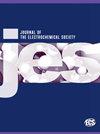Nitride Lithium-ion Conductors with Enhanced Oxidative Stability
IF 3.3
4区 工程技术
Q2 ELECTROCHEMISTRY
引用次数: 0
Abstract
It is desirable to develop solid electrolytes that have both excellent reductive stability against lithium metal and oxidative stability against high-voltage cathodes. However, no inorganic superionic conductors reported thus far satisfy these criteria. Nitrides exhibit intrinsically superior stability against reduction but are often readily oxidized at voltages as low as 0.6 V. In this article, we investigated all nitride-based compounds to search for materials with improved oxidative stabilities over 2.0 V while retaining their intrinsic stability against Li metal. We found two compounds, LiPN2 and Li2CN2, with high oxidative stability > 2.0 V and low vacancy migration energies. Using fine-tuned CHGNet machine-learning interatomic potential, we found that upon introducing aliovalent dopants to introduce vacancies in Li2CN2, the dopant and vacancy strongly anchor with each other to result in trapped vacancies, which lowers ionic conductivity. In contrast, vacancies and dopants have minimal interactions in LiPN2, resulting in a high ionic conductivity. These two compounds were synthesized, but their ionic conductivities were not successfully measured because of the challenges in densification. With improved processing conditions, these compounds may serve as anode-side separators in dual-separator-type all-solid-state batteries or anode buffer layer materials interfaced with lithium metal.氧化稳定性更强的氮化物锂离子导体
开发既对锂金属具有出色的还原稳定性,又对高压阴极具有出色的氧化稳定性的固体电解质是非常理想的。然而,迄今为止所报道的无机超离子导体均不符合这些标准。在本文中,我们对所有氮化物基化合物进行了研究,以寻找氧化稳定性更好(超过 2.0 V)、同时对锂金属保持固有稳定性的材料。我们发现 LiPN2 和 Li2CN2 这两种化合物具有大于 2.0 V 的高氧化稳定性和较低的空位迁移能。利用微调的 CHGNet 机器学习原子间势,我们发现在 Li2CN2 中引入等价掺杂剂以引入空位时,掺杂剂和空位会彼此强烈锚定,导致空位俘获,从而降低离子电导率。与此相反,空位和掺杂剂在 LiPN2 中的相互作用极小,因此离子导电率很高。我们合成了这两种化合物,但由于在致密化方面存在挑战,因此未能成功测量它们的离子导电率。随着加工条件的改善,这些化合物可用作双分离器型全固态电池的阳极侧分离器或与锂金属连接的阳极缓冲层材料。
本文章由计算机程序翻译,如有差异,请以英文原文为准。
求助全文
约1分钟内获得全文
求助全文
来源期刊
CiteScore
7.20
自引率
12.80%
发文量
1369
审稿时长
1.5 months
期刊介绍:
The Journal of The Electrochemical Society (JES) is the leader in the field of solid-state and electrochemical science and technology. This peer-reviewed journal publishes an average of 450 pages of 70 articles each month. Articles are posted online, with a monthly paper edition following electronic publication. The ECS membership benefits package includes access to the electronic edition of this journal.

 求助内容:
求助内容: 应助结果提醒方式:
应助结果提醒方式:


